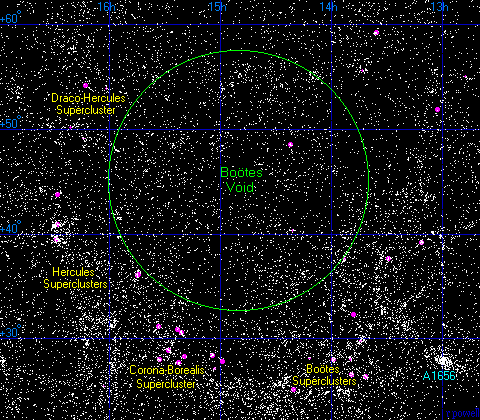
What is the Boötes Void? The Boötes Void is an area of space 330 million light years across that only contains 60 galaxies. It is found in the constellation known as Boötes. It is sometimes called the “Great Nothing”.
The Boötes Void was discovered by an astronomer called Robert Kirshner in 1981. He was looking for galaxies that have redshifted and he came across this big empty area. (Galaxies redshift when they are moving away from us. As they get further away, the light from them gets stretched and longer wavelengths of light are red. The opposite is blueshifting, for galaxies that are moving towards us. Their wavelengths are shortened and we see that as blue light.) The Boötes Void is 700 million light-years away from Earth and it is basically a gap in space that has very few galaxies in it. A space of 330 million light years would be expected to have roughly 2,000 galaxies, but the Boötes Void only has 60 galaxies. All of these galaxies are in a tube-shaped area across the middle of the void. It is definitely a space because light from behind it can be seen. There are other areas that look like voids, but are actually dark nebula, which are clouds of dust and gas so dense that light cannot pass through them.
The fact that there is a giant void in space seems like an ominous thing and people have read a lot into it. However, Boötes Void is not the largest void by a long way and voids in space are not that unusual if you stop to think about them. The largest known void is called LOWZ North 13788 void. It is a very catchy name. The void is 2,953,000,000 light-years across. That makes it ten times bigger than the Boötes Void. It has 109,066 known galaxies in it. I think one of the problems we might have here is actually defining what a void is. The are technically immense spaces that contain very few galaxies. I guess 100,000 galaxies in such a large space counts as “few”. Our Milky Way Galaxy is also said to be in a void. Our void is called the Local Hole and it is 2 billion light-years across. Whether or not we are actually in a void, though, is disputed. On Wikipedia’s list of voids in space, Boötes Void comes in at number 70, so it is not that large. One of these is aptly called the Great Void and it is 1.3 billion light-years across. It contains 17 galaxy clusters in a small region in the middle.
There are several ways voids like this can form and none of them are very mysterious. The first goes back to the law of very big numbers. Because the universe is so large (infinite?), we should expect everything possible to happen. It would be stranger if the universe was completely uniform than for it to have large gaps with nothing. Conversely, there are large sections that will have more galaxies than average, but we don’t see those as mysterious.
The second reason must be gravity. Heavenly bodies attract each other and the larger they are, or the more there are of them, the more attractive power they will have. It makes sense that galaxies will be attracted towards each other and if that is consistently happening, then there must be places where these galaxies are being pulled from. These would be the voids.
The third reason is that not all of the movement from the very beginning of the universe was uniform. In the Big Bang, all matter was blown outwards, but it didn’t all travel in perfect lines at exactly the same speed. There were a lot of fluctuations on the quantum level that caused some pieces of matter to clump together more than others. When those whizzed out and became the universe, it meant that there were some areas with more matter and some areas with less matter.
The fourth reason might be that there is more heat energy in the areas with galaxies and less heat energy in the voids. Galaxies with more energy have more mass because energy and mass are the same thing. More mass means a stronger gravitational pull. Once an area has matter, it is going to attract more matter. And when an area of space is empty, it is not going to be able to attract matter and will slowly get larger. Over trillions of years, the universe will probably devolve into areas that have a lot of matter and enormous voids. And this is what I learned today.
Try these next:
Sources
https://en.wikipedia.org/wiki/Bo%C3%B6tes_Void
https://www.skyatnightmagazine.com/space-science/bootes-void
https://en.wikipedia.org/wiki/List_of_largest_cosmic_structures#List_of_largest_voids
https://www.esa.int/Science_Exploration/Space_Science/What_is_red_shift
https://en.wikipedia.org/wiki/Giant_Void
https://bigthink.com/13-8/universe-quantum-fluctuation
https://en.wikipedia.org/wiki/Local_Hole
image By The original uploader was El C at English Wikipedia. – Transferred from en.wikipedia to Commons by Shizhao using CommonsHelper., CC BY-SA 2.5, https://commons.wikimedia.org/w/index.php?curid=34928058
